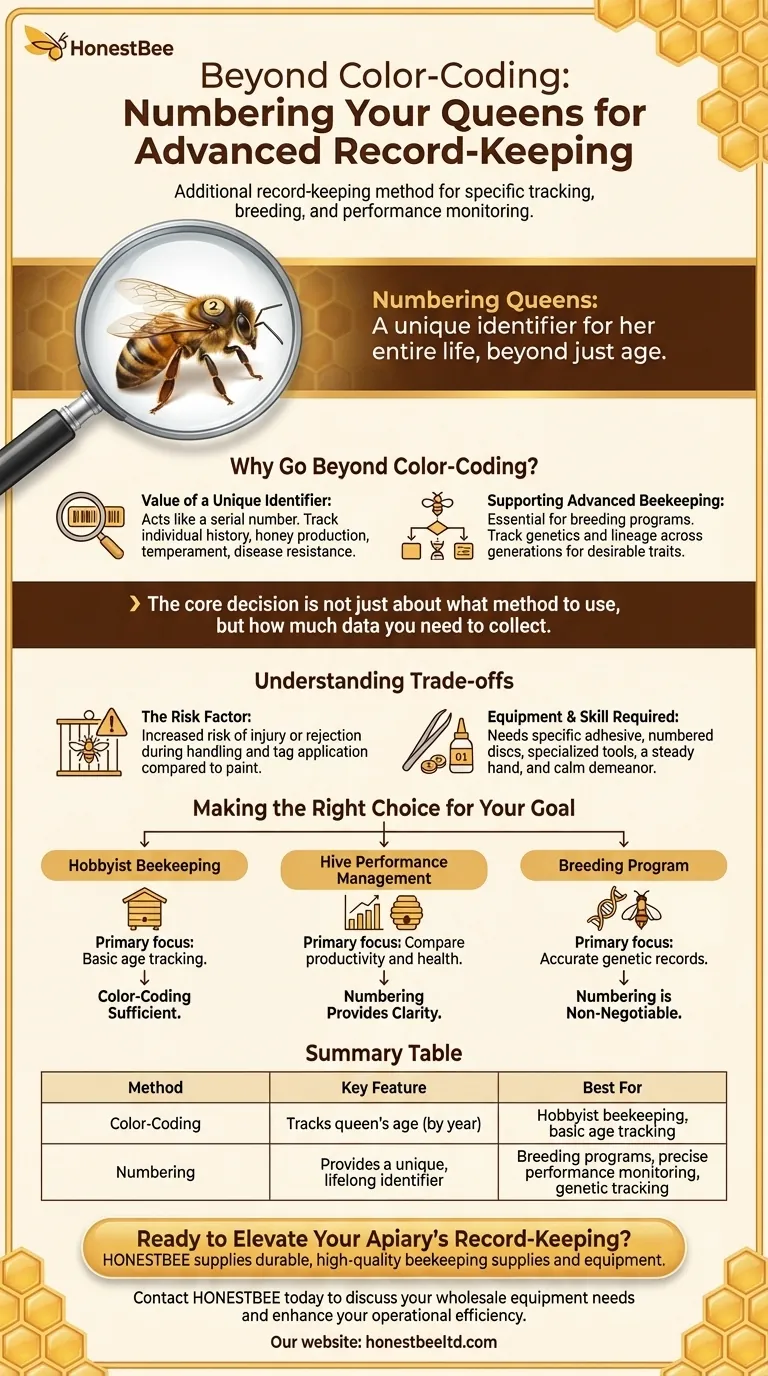In addition to color-coding, some beekeepers number their queens. This practice involves adding a small, numbered tag to the queen's thorax, allowing for highly specific tracking of individual queens beyond just their age. This level of detail supports more advanced beekeeping practices, such as breeding programs and precise performance monitoring.
The core decision is not just about what method to use, but how much data you need to collect. While color-coding tracks a queen's age, numbering provides a unique identifier for her entire life, enabling far more granular record-keeping.

Why Go Beyond Color-Coding?
The international color code is an excellent system for quickly identifying a queen's age at a glance. However, it's a batching system; every queen introduced in a given year has the same color. Numbering provides a level of specificity that color alone cannot.
The Value of a Unique Identifier
A unique number assigned to a queen acts like a serial number. This allows a beekeeper to track her individual history with complete certainty.
You can link detailed notes—such as honey production, temperament, and disease resistance of her colony—directly to that specific queen.
Supporting Advanced Beekeeping
For beekeepers engaged in queen rearing or breeding programs, unique identification is essential. It allows for tracking genetics and lineage across multiple generations.
This data is critical for making informed decisions about which genetic lines to propagate for desirable traits.
Understanding the Trade-offs
Adding a numbered disc is not a trivial task. It requires more time, specialized equipment, and a higher degree of skill than simply dabbing a spot of paint.
The Risk Factor
Marking any queen carries a small risk. The process of catching and handling her can be stressful, and there is a slight chance of injuring her or causing the colony to reject her.
Applying a numbered tag is a more involved process than using a paint pen, slightly increasing this risk.
The Equipment and Skill Required
You need specific, non-toxic adhesive and numbered discs, in addition to tools for carefully handling the queen.
Applying the disc securely without harming the queen requires a steady hand and a calm demeanor. For many, the added effort may not justify the data gained.
Making the Right Choice for Your Goal
Deciding whether to number your queens depends entirely on your beekeeping objectives.
- If your primary focus is hobbyist beekeeping: Sticking with the standard color code is almost always sufficient for tracking queen age and knowing when to replace her.
- If your primary focus is tracking hive performance for management: Numbering provides a clear way to compare the productivity and health of colonies led by specific queens.
- If your primary focus is a breeding program: Numbering your queens is a non-negotiable requirement for maintaining accurate genetic records.
Ultimately, your record-keeping should be a tool that serves your goals, not an obligation that complicates your work.
Summary Table:
| Method | Key Feature | Best For |
|---|---|---|
| Color-Coding | Tracks queen's age (by year) | Hobbyist beekeeping, basic age tracking |
| Numbering | Provides a unique, lifelong identifier | Breeding programs, precise performance monitoring, genetic tracking |
Ready to Elevate Your Apiary's Record-Keeping?
Whether you're a commercial apiary optimizing hive performance or a distributor supplying the best tools, precise queen management is key to success. Numbering queens enables the detailed data tracking essential for modern, profitable beekeeping.
HONESTBEE supplies the durable, high-quality beekeeping supplies and equipment—including queen marking kits—that commercial operations and distributors trust. Let us help you implement advanced management practices with the right tools.
Contact HONESTBEE today to discuss your wholesale equipment needs and enhance your operational efficiency.
Visual Guide

Related Products
- Jenter Queen Rearing Kit Complete Set for Bee Breeding
- Nicot Queen Rearing Kit for Beekeeping and Grafting in Nicot System
- No Grafting Queen Rearing Kit: System for Royal Jelly Production and Queen Rearing
- Retractable Chinese Queen Rearing Grafting Tools Equipment
- Brown Nicot Queen Cell Cups for Breeding Queen Bees Beekeeping
People Also Ask
- What is the timeline for queen breeding? A 28-Day Guide from Egg to Laying Queen
- How can beekeepers start a honey bee breeding program? Build a Superior, Resilient Apiary
- What genetic pathways differ in QE-queens? Unlocking the Master Controls of Queen Bee Biology
- What happens to the colony population during the 5–6 weeks after a new queen emerges? Understand the Natural Dip and Rebound
- What were the size differences among queens reared from worker larvae? Maternal Origin Determines Queen Size














